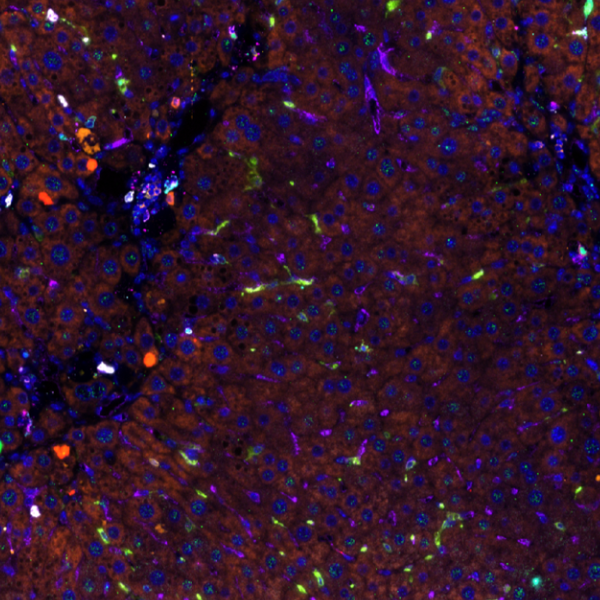press-releases
Lunaphore announces new data in immuno-oncology (IO) and liver disease research, highlighting broad spatial biology capabilities at EACR 2023
Date

LAUSANNE, Switzerland – June 08, 2023– 4:00 pm (CEST) – Lunaphore, a Swiss life sciences company developing technology to enable spatial biology in every laboratory, today announced new data presented at the 2023 Annual Congress of the European Association for Cancer Research (EACR 2023), taking place June 12 – 15, 2023 in Torino, Italy. The data, shared in collaboration with Cell Signaling Technology (CST) and Centre de Recherche des Cordeliers (CRC), highlights the capabilities of Lunaphore’s COMET™ platform in the study of the immune status of the tumor microenvironment (TME), immune response across tumor subtypes, and in charting the immune landscape of liver pathology.
Presentations
Studying the immune status of the tumor microenvironment with automated hyperplex immunofluorescence (Rivest, F. et al.)
Poster number: EACR23-0431
Date and time: Wednesday, June 14, 10:15 am – 6:15 pm CEST
Speakers:
- Dr. Pamela Pulimeno, Scientific Marketing Manager, Lunaphore
- Andrew Thompson, Distributor Manager, EMEA, CST
Data presented in partnership with CST highlights how a better understanding of the underlying mechanisms controlling anti-tumor immune response and tumor-intrinsic resistance to intervention is crucial for further innovation and improved therapeutic approaches. For this study, researchers designed and optimized a novel, sequential immunofluorescence (seqIF™) 22-biomarker hyperplex panel for use on COMET, including SPYRE™ Immuno-Oncology Core Panel expanded with Lunaphore’s Cytokeratin Mouse Monoclonal Antibody and eight antibodies from CST. The study shows a full end-to-end workflow that allowed automated, in-depth characterization of the immune compartment in the context of the TME, with a focus on immune checkpoint biomarkers.
Results reinforced that the seqIF™ protocol delivers a solution to design and execute off-the-shelf, same-species antibody panels and enables simultaneous interrogation of otherwise incompatible biomarkers, without a need for antibody labeling. The COMET™ platform provides spatial data allowing in-depth sample analyses at the single-cell level, expanding the resolution of the cell phenotyping.
Using high-plex immunofluorescence to study the immune contexture of Hepatoblastoma (Pire, A., et al.)
Poster number: EACR23-0941
Date and time: Wednesday, June 14, 10:15 am – 6:15 pm CEST
Speaker:
- Dr. Aurore Pire, Pediatric Surgeon and Ph.D. student, CRC
Research conducted by CRC had previously used transcriptomic classification to study hepatoblastoma (HB), the most frequent pediatric liver cancer. This research revealed three coexisting transcriptomic subtypes (‘Hepatocytic’,’ Progenitor’, and ‘Mesenchymal’) characterized by their differentiation, proliferation, and immune infiltration status and their association with the histology (fetal, embryonal, and mesenchymal cells). They identified that the ‘progenitor’ subtype is immune cold, chemoresistant, and at the origin of relapse. The new data outlines how studying immune contexture in HB will help determine how the immune infiltrate participates in a tumor’s response to chemotherapy and how certain tumor types can escape the immune response.
Utilizing Lunaphore’s COMET™ and SPYRE™ IO Core Panel, researchers confirmed that HB is a highly heterogeneous tumor type. Results showed that the embryonal component was less differentiated and more proliferative than the fetal component. Furthermore, the fetal component of the tumor was more enriched with immune cells than the embryonal component, which lacked such an infiltrate. In some cases, immune barrier between these two components was present. This highlights a strong immune escape mechanism and hints at why those patients might be resistant to chemotherapy, reinforcing that better understanding of the HB microenvironment could have a clinical impact on therapeutic strategies.
“Regarding the high heterogeneity of HB, in both immune infiltration and tumor cells, with the use of the COMET™ platform, we want to develop a signature that could easily triage those two types of HB and understand why HB patients respond to chemotherapies,” said Dr. Aurore Pire, Pediatric Surgeon and Ph.D. student at CRC. “Of note, immunotherapy as anti-PD-(L)1 is rarely used in pediatrics. Based on the Immunoscore Immune Checkpoint introduced by Dr Jérôme Galon in 2023, a simple bench-to-digital pathology assay, we will use this cohort of HB patients as a validation protocol (of poor-response). If some patients could benefit from these markers of response to anti-PD-(L)1 immunotherapies, that could be a major win for them.”
Sponsored Symposium
Additionally, Lunaphore and CRC will hold a symposium, discussing two case studies on the utilization of the COMET™ platform to explore the spatial immune landscape across liver diseases.
Multiplex immunofluorescence as a tool to explore spatial immune landscape across liver diseases.
Date and time: Monday, June 12, 12:15 – 1:00 pm CEST
Speakers:
- Dr. Aurore Pire, Pediatric Surgeon and Ph.D. student, CRC
- Dr. Amine Majdi, Post-doctoral Researcher, CRC
- Dr. Pamela Pulimeno, Scientific Marketing Manager, Lunaphore
Dr. Pire will discuss the spatial heterogeneity of tumor cells and microenvironment in HB, expanding on how a deep mapping of the tumor is shedding new light on the underlying cellular interactions. Dr. Madji will also share data on the emerging role of immunogenic cell deaths in the pathogenesis of nonalcoholic fat liver disease, explaining how spatial distribution of cell population is associated with the prognosis.
To learn more about Lunaphore’s presentations at EACR, please visit: https://lunaphore.com/our-events/eacr-2023/
To learn more about Lunaphore, please visit: https://lunaphore.com/
About Lunaphore
Lunaphore Technologies S.A. is a Swiss company born in 2014 with the vision of enabling spatial biology in every laboratory. Lunaphore provides solutions based on a game-changing chip technology that can extract spatial proteomic and transcriptomic data from tumors and other tissues, transforming any assay into multiplex spatial biology through a streamlined and easily integrated process. Lunaphore empowers researchers in immunology, immuno-oncology, and neuroscience to push the boundaries of scientific discovery and drug development. Lunaphore’s technology enables the identification of biomarker “signatures” with clinical relevance to support the development of diagnostic tools and streamline clinical trials, to ultimately improve patient outcomes. For further information on Lunaphore and its products, please visit https://lunaphore.com.